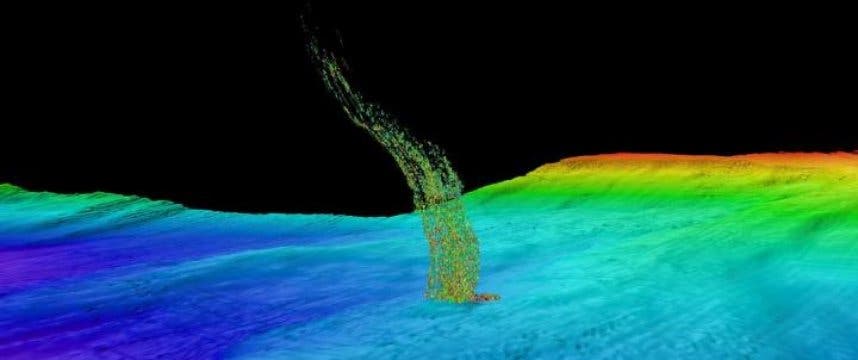The first such survey in the area revealed hundreds of bubble columns, mostly located along a geologic fault.

Sonar image of bubbles rising from the seafloor off Washington’s coast. This is from a 2014 survey in deeper water: The base of the column is 1/3 of a mile (515 meters) deep and the top of the plume is at 1/10 of a mile (180 meters) deep. Image credits: Brendan Philip /University of Washington.
For a while now, scientists have noticed columns of bubbles rise from the seafloor near Washington — as if a sleeping dragon were lying below. But far from being a dragon, these bubbles are actually caused by methane squeezed out of seafloor sediment and rising up through the water.
These bubble plumes are clustered in a north-south band about 30 miles (50 kilometers) from the coast. The gas and fluid are associated with geological faults generated by the motion of geologic plates that produce major offshore earthquakes in the Pacific Northwest.
In order to map their distribution, researchers analyzed data from multiple research cruises over the past decade, using sonar technology to map the seafloor and generate images of gas bubbles within the overlying water. The locations where they emerge provide important clues to what will happen during a major offshore earthquake. Seismic surveys used for oil exploration in the 70s and 80s which are now publicly available were also used in the survey.
“We found the first methane vents on the Washington margin in 2009, and we thought we were lucky to find them, but since then, the number has just grown exponentially,” said lead author Paul Johnson, a UW professor of oceanography.
These aren’t exactly strong volcanic-type methane vents — more like champagne bubbles. They’re also a bit unpredictable.
“These vents are a little ephemeral,” Johnson added. “Sometimes they turn off-and-on with the tides, and they can move around a little bit on the seafloor. But they tend to occur in clusters within a radius of about three football fields. Sometimes you’ll go out there and you’ll see one active vent and you’ll go back to the same location and it’s gone. They’re not reliable, like the geysers at Yellowstone.”
However, there’s so many of them that if you’re in the area, you’re never too far from one.
“If you were able to walk on the seafloor from Vancouver Island to the Columbia River, you would never be out of sight of a bubble plume,” Johnson said.
These gas emissions actually have a beneficial effect to the local community: they provide important nutrients for local bacteria, which in turn end up feeding and supporting the ecosystem, meaning that these sites are productive fishing grounds.
These vents could also help researchers better assess the earthquake hazard from the Cascadia Subduction Zone, which last ruptured more than 300 years ago.
Journal Reference: Johnson at al. Anomalous Concentration of Methane Emissions at the Continental Shelf Edge of the Northern Cascadia Margin. Journal of Geophysical Research. DOI: 10.1029/2018JB016453









